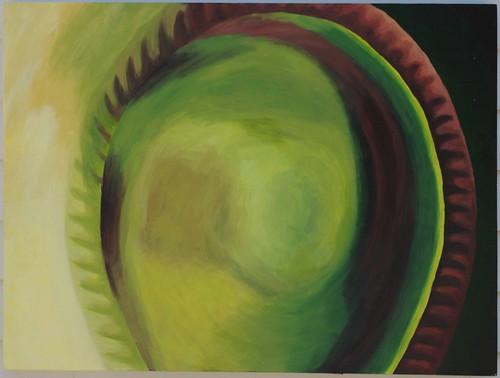Before I start however, a twitter contact, Edward Kinnally, let me know about an article he wrote on art material safety which covers the standards applying to paint. Ever wondered what "non-toxic" really means? That one was a shocker for me.

Perrier Bottle
30"x40" acrylic on canvas
2007 Caroline Roberts
So, how can we blend when the paint dries so fast? Here I painted the base of a perrier bottle in the (attempted) style of Georgia O'Keefe. I used acrylic paints and in some areas I managed blending that I am very pleased with. My 'trick'? I mixed the main hues that I needed ahead of time and worked one small blending area at a time, blending my paint as much on the palette as on the canvas. I also keep a spray bottle on hand and regularly mist the palette and the canvas to keep the paint workable. When I feel the paint dragging at my brush I stop work on that area - the dragging means that a skin is forming and continuing to work will only make the paint textured and lumpy. If I have to stop before I'm happy with the blending then I simply come back after that layer is dry and repaint the areas that didn't work.For a palette I mainly use a piece of glass with white paper taped underneath. I spray it regularly with water to keep the paint from drying and i cover it with plastic wrap (or cling film in the UK) to keep it from drying between sessions. I also use freezer paper which is the same as those disposable paper palettes but much cheaper. I have a stay-wet palette but I don't often use it because I find the surface a little small. It's good for studies and smaller canvases. Depends how big, or messy, you work really. For large quantities of paints or glazes I re-use paint pots, glass spice jars and plastic medicine pots. I am probably stating the obvious, but if you restrict the surface area you slow down the drying, so these little pots can keep a glaze workable for weeks if I close it up after use.
Now, I freely confess, I have very little experience with oil paint because I don't like the smell of turps and I have eczema so have avoided mineral spirits (this was before I learnt I should wear gloves whilst painting). What a career-long oil painter might see as restrictions on their normal way of working I see as normal limitations of a media.
Which is all another way of saying that I am making assumptions, based on the blog posts I read about acrylic paints, on the issues people find when they are new to acrylics. I would love to hear your questions so I know the real issues, and I will answer them as best I can. I am always learning something new about acrylics and I know there is so much more out there to know. I will share any discoveries I find to be repeatable.




Great! I am so impressed by these tips! These are really very effective. I like to paint. :-) Right now, I am learning about acrylic painting. One thing that I really like about this paint is, it dilutes in water but become water resistant when dry. Other aspects I like is that it’s odorless, anti-allergic and allows artist to use multi-layers.
ReplyDeleteI have found a website http://www.mazzoldi-best-acrylic-paintings.com/painting-with-acrylic.html where the painter Aurora Mazzoldi shares her paintings and the stories behind the art. I like her ideas very much.